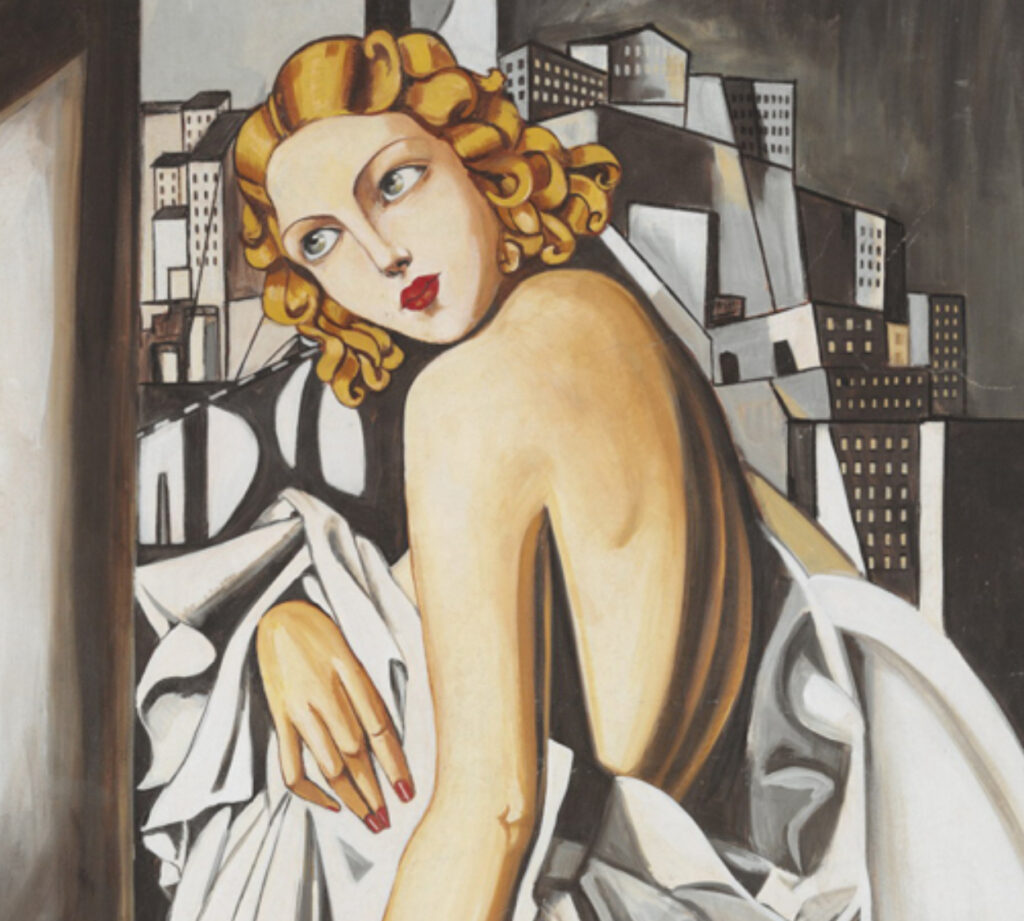
Tamara de Lempicka, the iconic Art Deco painter whose striking works captured the glamour and sensuality of the early 20th century, has always been an enigmatic figure. Known for her bold lines, vibrant colors, and depictions of strong, modern women, Lempicka’s life was as daring and unconventional as her art. This legacy is explored in depth in The True Story of Tamara de Lempicka, a documentary that made its debut at the Mill Valley Film Festival in September.
Directed by an eclectic team, the film pieces together Lempicka’s life and work through a variety of lenses: her celebrated paintings, archival materials, and personal recollections from family and experts. By doing so, it offers viewers an intimate look at the woman behind the canvas, going beyond the allure of her Parisian heyday to delve into her Hollywood period, her late years in America, and the cultural shifts that influenced her work.
Tamara de Lempicka: A Life Lived Boldly
Born in 1898 in Warsaw, Poland, Lempicka’s early life was marked by privilege and turmoil. She married Tadeusz Lempicki, a Polish lawyer, and fled to Paris following the Russian Revolution. It was in the French capital that Lempicka reinvented herself, both personally and professionally. She studied painting and developed her distinctive style, which combined the geometric precision of Cubism with the sleek elegance of Art Deco.
Her portraits of aristocrats, artists, and society figures quickly garnered attention, making her one of the most sought-after portraitists of her time. Yet, her story was far from conventional. Lempicka lived openly as a bisexual woman, navigating relationships with both men and women in an era when such openness was rare. Her audacious lifestyle, combined with her unapologetically modern art, made her a fascinating figure in Paris’s avant-garde circles.
A Documentary Unveiled
The True Story of Tamara de Lempicka engenders Lempicka’s life to vivid life through a mix of narrative techniques. The documentary is anchored by the voices of her granddaughter and great-granddaughters, who provide personal insights into Lempicka’s personality, ambitions, and struggles. Their memories, combined with archival photos and never-before-seen home videos, paint a deeply personal portrait of the artist.
The film also leans on animation to bring Lempicka’s works to life, offering a dynamic visual experience that mirrors her bold artistic style. Her paintings, which often depict powerful women in commanding poses, are interwoven with narration by Anjelica Huston, adding a layer of gravitas and connection to Lempicka’s theatrical influence.
Art and Expertise: The Outside View
In addition to family perspectives, the documentary includes commentary from art dealers and historians, providing a broader context for Lempicka’s work. Experts delve into the significance of her style, which blended tradition with modernity, and her ability to capture the spirit of her time. From her use of industrial aesthetics to her unabashed celebration of sensuality, Lempicka’s art is examined as both a product and a critique of the era in which she lived.
Eden Espinosa, who portrayed Lempicka in the Broadway musical Lempicka, also appears in the documentary, adding another layer of interpretation to the artist’s life. Espinosa’s insights, alongside those of composer Matt Gould, who wrote the music for the production, explore how Lempicka’s story has been adapted and interpreted for contemporary audiences.
From Paris to Hollywood: The Many Faces of Lempicka
While much of Lempicka’s fame is tied to her Parisian years, the documentary ventures beyond this period to examine her later life in Hollywood and the United States. During the 1930s, Lempicka moved to America with her second husband, Baron Raoul Kuffner, as World War II loomed over Europe. In Hollywood, she painted portraits of film stars and elite socialites, further cementing her reputation as a symbol of glamour and sophistication.
However, her later years were marked by a sense of restlessness and reinvention. Lempicka’s style evolved as she experimented with different artistic movements, including abstraction, though these works were less commercially successful. As the art world shifted toward Abstract Expressionism in the mid-20th century, her earlier Art Deco works fell out of favor. The film doesn’t shy away from this decline, portraying Lempicka as a complex figure navigating the challenges of aging and artistic relevance.
Anjelica Huston’s Narration: A Theatrical Connection
Anjelica Huston’s narration serves as a guiding thread throughout the documentary. Huston’s connection to Lempicka is particularly meaningful, as she portrayed the artist in the 1980s Los Angeles production of Tamara, a play that brought Lempicka’s life to the stage in an immersive, non-linear format. Huston’s distinctive voice lends an air of authority and reflection, bridging the theatrical and documentary worlds in a way that honors Lempicka’s dramatic spirit.
A Legacy Revisited
The documentary closes with a look at how Tamara de Lempicka’s work has been rediscovered and celebrated in recent years. From exhibitions in major museums to her influence on contemporary fashion and design, Lempicka’s legacy has experienced a resurgence. Her bold, glamorous depictions of women have become synonymous with the Art Deco movement, and her life story continues to inspire new generations of artists, writers, and performers.
This resurgence is not just about her art but also about her defiance of societal norms. As a woman who thrived in male-dominated spaces, lived openly as a bisexual, and embraced modernity in all its forms, Lempicka’s story resonates powerfully in today’s world. The film captures this enduring relevance, showing how her work and life remain as compelling as ever.
The True Story of Tamara de Lempicka is more than a biography; it is an exploration of art, identity, and legacy. By combining family narratives, expert analysis, and innovative visuals, the film offers a nuanced and vibrant portrait of one of the 20th century’s most fascinating artists.
No comments yet.








